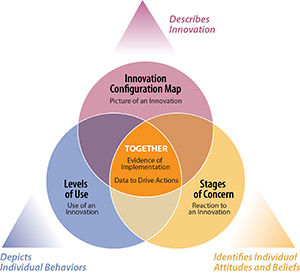Concerns-Based Adoption Model (CBAM)
Many education leaders have adopted a new reform or initiative with high hopes, only to see it produce few results. Successfully implementing a new program involves more than providing staff with materials, resources, and training. An often overlooked factor is the human element—the people actually doing the work. Each person will respond to a new program with unique attitudes and beliefs, and each person will use a new program differently. The three diagnostic dimensions of the Concerns-Based Adoption Model (CBAM) provide tools and techniques that enable leaders to gauge staff concerns and program use in order to give each person the necessary supports to ensure success.
The Three Diagnostic Dimensions
The effective implementation of a new program is a highly personal developmental process. The diagnostic dimensions of CBAM are three components for assessing and guiding this process:
- Innovation Configurations: An Innovation Configuration Map provides a clear picture of what constitutes high-quality implementation. It serves as an exemplar to guide and focus staff efforts.
- Stages of Concern: The Stages of Concern process, which includes a questionnaire, interview, and open-ended statements, enables leaders to identify staff members’ attitudes and beliefs toward a new program or initiative. With this knowledge, leaders can take actions to address individuals’ specific concerns.
- Levels of Use: The Levels of Use interview tool helps determine how well staff, both individually and collectively, are using a program. Levels range from nonuse to advanced use. When combined with the Innovation Configuration and first-hand observations, this information can help staff effectively implement a new program.
Used at regular intervals, these components help pinpoint the issues that staff are having as they strive to master a new program. Leaders can then problem solve how best to help staff members achieve high-quality program implementation. Change often requires not only gaining new skills, but shifting one’s attitudes and beliefs. As individual comfort level and competence with a program increases, staff can move beyond their personal concerns to focus on the desired outcomes, such as increasing student achievement.
Use and Application
How can the data be used?
The CBAM diagnostic dimensons provide evidence of the current extent and quality of implementation that leaders can use to drive decisions and actions. For example, the Stages of Concern Questionnaire may indicate that teachers are worried about how much preparation time a new math curriculum requires. With this knowledge, school leaders can provide support targeting that specific concern. They may, for instance, temporarily provide teachers with more planning time by excusing them from some duties.
Can the CBAM diagnostic dimensions be used separately as well as together?
Yes. Depending on their specific goals and situation, leaders may want to use only one or two of the these tools. However, using various combinations of the three will provide a clearer picture of how well implementation of a program or initiative is progressing.
What type of support does SEDL provide for CBAM?
SEDL offers a range of support for CBAM. We sell publications that describe the CBAM framework and components in depth, providing a solid foundation. Other support includes training classes, available both face-to-face and online. We also offer on-site support tailored to an organization’s specific program and context. In such cases, staff with the Center for High-Performing Schools at SEDL work with district and school leaders to develop and deliver customized technical assistance and training. Our consultants can also assist in determining the best ways to apply CBAM data in the district or school. Please visit https://www.air.org/resource/cbam-concerns-based-adoption-model to learn more about the services we provide.
Research Base
The Concerns-Based Adoption Model was developed in the 1970s and 1980s by a team of researchers at the Research and Development Center for Teacher Education at the University of Texas at Austin. Since its development, researchers have tested CBAM for reliability and validity; in 2006, it was updated to ensure its accuracy. Today, CBAM continues to be applied in a range of school, organizational, and research settings. The tools are commonly used to help leaders, evaluators, and researchers understand, monitor, and guide the complex process of implementing new and innovative practices. To learn more, consult the following resources:
- George, A. A., Hall, G. E., & Stiegelbauer, S. M. (2006). Measuring implementation in schools: The Stages of Concern Questionnaire. Austin, TX: SEDL. Available from http://www.sedl.org/pubs/catalog/items/cbam17.html
- George, A. A., Hall, G. E., Stiegelbauer, S. M., & Litke, B. Stages of Concern Questionnaire online [Computer software]. Available from http://www.sedl.org/pubs/catalog/items/cbam21.html
- Hall, G. E., Dirksen, D. J., & George, A. A. (2006). Measuring implementation in schools: Levels of Use. Austin, TX: SEDL. Available from http://www.sedl.org/pubs/catalog/items/cbam18.html
- Hall, G. E., & Hord, S. M. (2015). Implementing change: Patterns, principles and potholes (4th ed.). Upper Saddle River, NJ: Pearson.
- Hord, S. M., Rutherford, W. L., Huling, L., & Hall, G. E. (2006; revised PDF version uploaded on Lulu.com, 2014). Taking charge of change. Austin, TX: SEDL. Available from http://www.sedl.org/pubs/catalog/items/cha22.html
- Hord, S. M., Stiegelbauer, S. M., Hall, G. E., & George, A. A. (2006). Measuring implementation in schools: Innovation configurations. Austin, TX: SEDL. Available from http://www.sedl.org/pubs/catalog/items/cbam19.html
SEDL Products and Professional Development for CBAM
- Buy the manuals:
- Read Taking Charge of Change a readable introduction to the CBAM method of predicting teacher behavior during a change process.
- Watch the recording of the complementary webinar, CBAM 101: Getting Your Feet Wet.
- Request a demo account for the online survey, The Stages of Concern Questionnaire Online.
- Contact Garry Davis at gdavis@air.org for information about certification for Levels of Use.
Click here for a PDF version of this page appropriate for printing.


